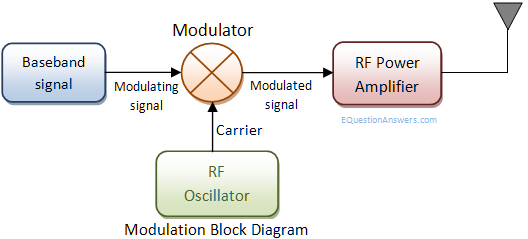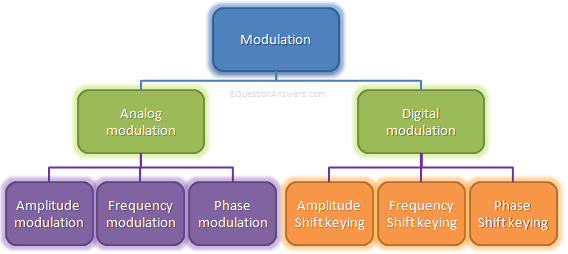Modulation
Communication
We convey our messages to other people through voice, facial expressions, gestures. These are the communication methods between people. These messages are often base-band audio, video and even digital bits from computers. Telecommunication is the core for sending messages from one place to another. Here, we are discussing various sorts of modulations which are used by telecommunication devices. Before we start this subject allow us to return to the history of telecommunication. Telephone was the primary device to send analog audio signals over long distance through copper wire. Telegraph was on the opposite was used to send messages within the sorts of dash-dots. Telephone and telegraph remains the base of all modern day's communication. These days we send audio, video, bit streams from computers through copper wires, co-axial cable, even through wireless radio waves, microwaves, infrared, and with visual lights through glass fiber . Base-band signals are often sent to an extended way through copper wire but sending those to a long distance has many challenges.Need for Modulation:
Electronic devices produce messages like analog base-band signals in the form of audio, video or even messages can be in the form of digital bits from computer. To send these messages we must have some communication channel.- Voice, Video, bit streams from computer are having lower frequency band and can travel small distances with wires but cannot be sent through wireless media.
- Voice signal has lower Bandwidth therefore it will not propagate through space and will be attenuated.
- To transmit voice signal a large size antenna is required as antenna length is proportional to half of wavelength.
- The size of the antenna will be more than the distance between transmitter and receiver.
- When more than one transmitter is involved all station will overlap in one frequency band.
Problem:
- Voice, Video, bit streams from computer have lower frequency band.
- They can travel small distances with wires but not cannot propagate through space.
- Antenna size is half of the wavelength thus antenna length for Voice, Video, bit streams would be impractical.
- Even if we transmit Voice, Video, bit streams over an imaginary antenna but being in the same frequency range all channels will overlap.
Solution:
- The carrier signal is used to carry signal to a long distance.
- Modulation is used with a selected carrier frequency signal to mix base-band with carrier.
- Carrier frequency is in higher frequency radio wave length and thus antenna size would be smaller.
- Radio waves can travel longer distance with very less attenuation.
- The radio wave has a wide range of frequencies to select individual non-overlapping channels.
Modulation:
Now we have to develop some way to send the information of message signal via this carrier signal. The carrier signal may be a high frequency sinusoidal signal represented by amplitude, frequency and phase. We will vary one among this parameter accordingly with the message information.What is Modulation?
Modulation is an operation of varying amplitude or frequency or phase of carrier signal according to the instantaneous amplitude of the base-band signal/modulating signal.
Here base-band signals comes from a audio/video or computer. Base-band signals also are called modulating signal because it modulates carrier signal. Since carrier signals are high frequency radio waves it generally comes from a radio frequency oscillators. These two signals are combined in modulator. Modulator takes the instantaneous amplitude of base-band signal and varies amplitude/frequency/phase of carrier signal. Resultant signal is a modulated signal. It goes to an RF-amplifier for signal power boosting and is then fed to an antenna or a co-axial cable.
There are two sorts of modulation analog and digital. Analog modulation are used with the voice, video and regular waves of base band signals. Where as digital modulations are used with bit streams or symbols from computing devices as base band signals
What are the different types of modulations?
There are two categories of modulations: analog and digital. Here is a diagram showing the kinds of modulations and further the sub types of analog and digital modulation.
Ref :- https://www.equestionanswers.com/notes/modulation-analog-digital.php
Analog Modulation:
Analog modulation refers to the process of transferring analog low frequency base-band signal, like an audio or TV signal over a higher frequency carrier signal like a radio frequency band. There are three properties of a carrier signal amplitude, frequency and phase and thus there are three basic types of analog modulations -
- Amplitude Modulation (AM)
- Frequency Modulation (FM)
- Phase modulation (PM)
Comments
Post a Comment